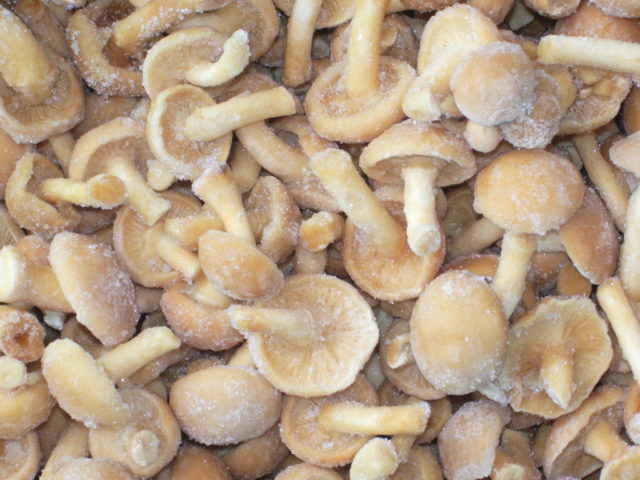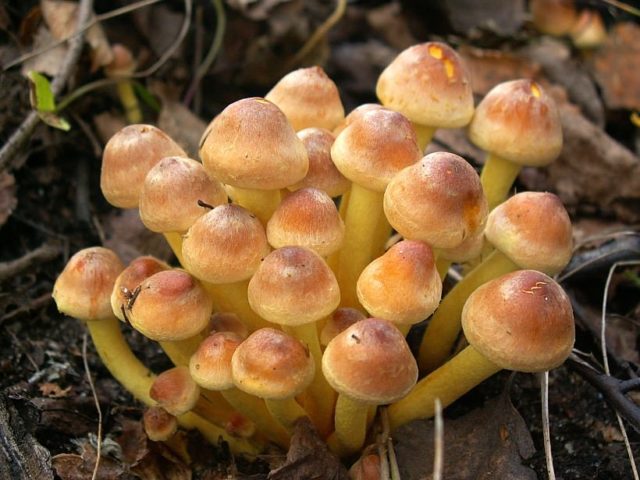Content
- 1 Are honey mushrooms dark in color?
- 2 What do spruce mushrooms look like?
- 3 Where and how do dark brown honey mushrooms grow?
- 4 Are spruce mushrooms edible or not?
- 5 How to cook spruce mushrooms
- 6 Medicinal properties of dark brown honey mushrooms
- 7 Growing spruce mushrooms on the plot or in the country
- 8 Doubles and their differences
- 9 Interesting facts about spruce mushrooms
- 10 Conclusion
One of the most beloved mushrooms is honey mushrooms.Growing on stumps in large groups, they invariably attract the attention of mushroom pickers, not allowing them to leave with empty baskets. Popularly, this name refers to a whole group of mushrooms, but few people know that different types of mushrooms belong to separate genera and families. Thus, spruce honey mushrooms are very similar in appearance to autumn mushrooms, but are conditionally edible mushrooms.
Are honey mushrooms dark in color?
According to the description and photo, dark honey mushrooms (or spruce, hard, ground, lat. Armillaria ostoyae) belong to the Physalakriev family. They differ from other related representatives, as the name implies, by the dark brown color of the cap. The color of honey mushrooms largely depends on the place of growth, and spruce mushrooms got their color because they prefer predominantly spruce and pine darkened forests. The characteristic shade of the wood on which the mycelium is located is transmitted to the fruiting bodies, and pine bitterness directly affects their taste.
What do spruce mushrooms look like?
The spruce species can be easily recognized by its dark cap and cylindrical stem with a tuberculate or scaly surface. The pulp is loose, white, with a yellowish tint, and has virtually no mushroom smell. The photo shows young dark honey mushrooms growing in a spruce forest, where their poisonous counterparts, dangerous to human health, like to live together with them.
Spruce mushrooms are an autumn species and begin to bear fruit in early August.
Description of the cap
Convex at a young age, the cap of the spruce honey mushroom, completely covered with brown scales, grows from 4 to 10 cm in diameter. Its shape, hemispherical in young specimens, becomes more spread out in older ones.The color of the cap is dark brown, and underneath there are light plates, which become covered with reddish, brown spots with age.
Description of the leg
Honey mushrooms with a dark cap have a cylindrical stem, somewhat thickened at the base, with a height of 5 to 10 cm and a diameter of up to 2 cm, and a ring that in appearance resembles lace frills. The surface of the fruit body is dry, slightly rough.
Where and how do dark brown honey mushrooms grow?
Spruce mushrooms grow throughout the country, except for the northern regions, in deciduous, mixed, and more often coniferous forests. This species prefers to settle on stumps and rotting trees, dead wood and conifers. The species is quite rare under deciduous trees and shrubs. Spruce honey mushrooms bear fruit from the end of July to the end of October, depending on the specific climate zone. They are located in small families. This type of mushroom is called spruce because its favorite place to grow is the rotting remains of conifers, rotten stumps, and dead tree trunks.
Is it possible to collect dark mushrooms?
Dark, spruce mushrooms can be collected from about August until almost the onset of cold weather, that is, until the end of October - beginning of November. At the same time, specimens that are overripe, old, or with a cracked cap are not cut off. On one large stump or fallen tree trunk you can collect a whole basket of fragrant honey mushrooms.
Are spruce mushrooms edible or not?
Dark representatives of honey mushrooms are classified as conditionally edible, as they have a bitterish, specific taste. Before cooking, fruiting bodies need preliminary, preferably twice, boiling. The broth after processing the fruiting bodies is not used for food.
How to cook spruce mushrooms
Before preparing culinary dishes, spruce mushrooms are cleaned, all debris is removed, and the top layer is removed. Only the caps are used for food, since the legs become rubbery and rigid in structure when cooked. First, the fruiting bodies are boiled in salted water for 20 minutes, drained in a colander, and the broth is drained. The procedure is repeated again, which allows you to completely eliminate the unpleasant bitterness and natural resins. Next, a variety of dishes are prepared from the processed mushrooms.
How to fry spruce mushrooms in sour cream and onions
Boiled dark mushrooms are placed in a hot frying pan with vegetable oil and fried under a closed lid. After 15 min. add onion rings, add salt and pepper the dish. Add sour cream 3 minutes before the end of frying, while reducing the heat. Add a little butter. Sprinkle the prepared mushrooms with onions and finely chopped dill.
How to pickle dark autumn mushrooms
Ingredients:
- mushrooms – 1kg;
- salt - 2 tbsp. l.;
- sugar – 1 tbsp. l.;
- vinegar (9%) - 2 tbsp. l.;
- 2 - 3 buds of cloves, peeled cloves of garlic, peppercorns.
Cooking algorithm:
- A marinade of water, salt and sugar is cooked in a saucepan.
- After boiling, pour in vinegar, add pepper and cloves, and add previously prepared and boiled fruit bodies.
- Cook over medium heat for 10 - 15 minutes and place in sterilized jars.
- Place the garlic cloves, add the marinade almost to the neck and pour in 1 tbsp. l. vegetable oil on top of each jar.
- Cover with plastic lids, cool and store in the refrigerator.
Freezing dark brown honey mushrooms for the winter
Prepared dark spruce mushrooms Armillaria solidipes are placed in plastic containers or plastic bags and sent to the freezer. There is no need to put a large number of mushrooms in a bag or container: the volume should be such that they are enough to cook for one time.
Salting autumn spruce mushrooms for the winter
Ingredients:
- 1 kg of mushrooms;
- 1/2 tbsp. salt;
- 5 - 7 cloves of garlic;
- peppercorns and dill umbrellas.
Cooking algorithm:
- A layer of salt is poured onto the bottom of the enamel pan, then ground mushrooms are placed.
- The layers are alternated, sprinkled with garlic, dill and peppercorns.
- The pan is covered with gauze folded in two layers, a plate is placed and pressure is placed.
- The pickling process lasts about 20 days, after which the mushroom mass is transferred to clean jars and stored in a dark, cool place.
How to dry spruce mushrooms
After cleaning and removing forest debris, spruce mushrooms can be dried, which will allow maximum preservation of all nutrients. The fruiting bodies are strung on a thin thread and hung in a sunny, well-ventilated place. Dry for 40 days. The finished mushrooms become elastic and do not break when bent. Overdried honey mushrooms are fragile and crumble. You can easily prepare mushroom powder from them, which can then be conveniently used as a natural seasoning.
Medicinal properties of dark brown honey mushrooms
Honey mushrooms, brown and dark in color, are record holders for protein content and, although they contain a small amount of calories, can replace meat. This is especially true for people on dietary or vegetarian diets. The product contains a large number of microelements and vitamins, amino acids and natural sugar.
Due to its unique composition, spruce mushrooms are widely used in medicine as a treatment for:
- malignant and benign tumors;
- Escherichia coli and staphylococcus;
- thyroid diseases.
Regular consumption of mushroom dishes can delay the development of many pathologies. Mushroom pulp contains lecithin, which does not allow “bad” cholesterol to accumulate on the walls of blood vessels. This is the best prevention of atherosclerosis. The low glycemic index of the product makes it possible to include mushroom dishes in the diet of patients with diabetes.
Growing spruce mushrooms on the plot or in the country
Thanks to modern science, today you can grow any mushrooms on your own plot. To do this, you will need to purchase mycelium at a specialized store and be patient.
Algorithm of actions:
- Select a suitable tree from the summer cottage with signs of rotting, which will not be pitied: the mushrooms will destroy it during the growth process.
- The mycelium is moistened with water and covered with moss to prevent moisture evaporation.
- After 12 months, the first harvest will appear, after which the mycelium will actively bear fruit for 6 - 7 years.
Doubles and their differences
Honey fungus has edible and inedible counterparts among the mushrooms of the genus Openkov.During harvesting, it is necessary to distinguish between twins that bear fruit during this period of the year:
- Autumn honey fungus, which grows on various woody substrates, has a smooth surface of a honey-yellow cap and a yellow, without fringe, skirt on the stem. The mushroom is edible, but the technology for preparing the autumn and dark varieties is different, since conditionally edible mushrooms require more complex heat treatment.
- Bloated, Gallic (or thick-legged) honey fungus has a light brown cap and dark scales over its entire surface when young, which disappear as it matures. A mushroom with a thin ring that breaks and disappears as it ripens. When broken, the pulp emits a pleasant, cheesy aroma. The species is conditionally edible.
- False honey fungus and its varieties. They do not have the skirt on the stem and scales on the surface of the caps, which are characteristic of edible representatives. Unlike edible spruce mushrooms, they have a pronounced bitter taste: they are classified as conditionally edible or inedible, depending on the specific species. Inedible false representatives have a sharp, unpleasant odor and a smooth stem without inclusions, as can be clearly seen in the photo. The cap of the fruiting body has an uneven color.
A video about comparing edible mushrooms with false doubles will be useful for every novice mushroom picker
Interesting facts about spruce mushrooms
The honey fungus with a dark brown, scaly cap is capable of capturing vast areas covered with damp dead wood and the remains of rotting wood. What is located on the surface of the earth is only a small part of the mycelium, and the mycelium is located underground at a great distance. Thus, myceliums are often found in Swiss forests, the area of which is more than 30 hectares.
The largest and oldest mushroom in the world is the dark honey fungus, which grows in the USA, Oregon. The area of the mycelium of this village is about 850 hectares, and its age is more than 2.5 thousand years. A single giant organism, located under the surface of the earth, is a parasite and feeds on the roots of trees, which leads to their death. That's why they call it the Oregon monster.
Large harvests of mushrooms are rare: fruiting bodies appear once every 3-4 years.
Conclusion
Spruce honey mushrooms are similar in appearance to some related species that bear fruit in the fall, but upon careful examination it is not difficult to distinguish them. Despite belonging to the conditionally edible mushrooms, their popularity has not fallen for many years, and their taste qualities are rated very highly.






















